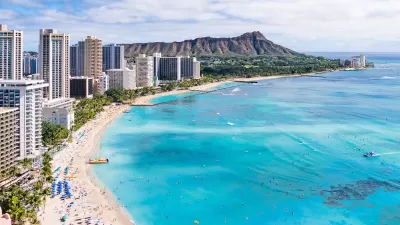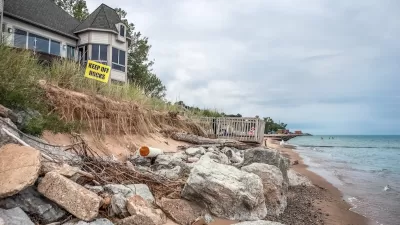This article from Architect Magazine wonders what coastal cities will look like after the sea level rises.
"As the oceans heat up, they expand-up to eight inches in height already-and melting glaciers in Greenland and Antarctica continue to pump up the volume. The flow of ice into the sea has doubled over the past decade and over the next century could cause a 20-foot rise, making densely populated regions like the Nile Delta uninhabitable. In the U.S., even three more feet would flood every city on the Eastern seaboard. If you remember the aerials in An Inconvenient Truth, you know how this might look: Whole coastlines shrink as water spills inland and redraws the map of the world."
"The ascent is likely to happen gradually, so there is time to plan. Mass migration is inevitable, but abandoning every affected area isn't practical. Monumental seawalls will spring up, but New Orleans' levees are a tragic demonstration that this strategy isn't fail-safe."
"The real test will come with larger metropolitan areas. A report released in December by the Organisation for Economic Co-operation and Development (OECD), an international governmental organization based in Paris, lists New York among the 10 places most threatened by future flooding. For a wealthy city, its protection is minimal, so the images of a deluged Manhattan in the 2004 film The Day After Tomorrow may not be a Hollywood fantasy."
FULL STORY: Water World

Americans May Be Stuck — But Why?
Americans are moving a lot less than they once did, and that is a problem. While Yoni Applebaum, in his highly-publicized article Stuck, gets the reasons badly wrong, it's still important to ask: why are we moving so much less than before?

Using Old Oil and Gas Wells for Green Energy Storage
Penn State researchers have found that repurposing abandoned oil and gas wells for geothermal-assisted compressed-air energy storage can boost efficiency, reduce environmental risks, and support clean energy and job transitions.

Placekeeping: Setting a New Precedent for City Planners
How a preservation-based approach to redevelopment and urban design can prevent displacement and honor legacy communities.

San Francisco’s Muni Ridership Grew in 2024
The system saw its highest ridership since before the Covid-19 pandemic, but faces a severe budget shortage in the coming year.

Colorado Lawmakers Move to Protect BRT Funding
In the face of potential federal funding cuts, CDOT leaders reasserted their commitment to planned bus rapid transit projects.

Safe Streets Funding in Jeopardy
The Trump administration is specifically targeting bike infrastructure and other road safety projects in its funding cuts.
Urban Design for Planners 1: Software Tools
This six-course series explores essential urban design concepts using open source software and equips planners with the tools they need to participate fully in the urban design process.
Planning for Universal Design
Learn the tools for implementing Universal Design in planning regulations.
Heyer Gruel & Associates PA
City of Moreno Valley
Institute for Housing and Urban Development Studies (IHS)
City of Grandview
Harvard GSD Executive Education
Salt Lake City
NYU Wagner Graduate School of Public Service
City of Cambridge, Maryland




























